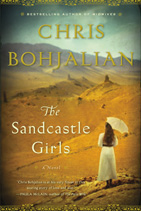Last week, the laundry sat on the chair in the den for several days, unfolded and wrinkling. I just couldn’t find a moment to fold it; each free second was spent reading The Sandcastle Girls, the new book from Chris Bohjalian.
Before I tell you more, it’s important to know what kind of books I enjoy. I love books that pull me in and envelop me in a story so moving and important that I’m compelled to check out of life for a little bit and race toward the last page. I like to learn something when I read, too, so historical fiction is always a winner. Finally, I’m a purist: I will not read ahead; I savor each page in order, respecting the author’s hard work.
The Sandcastle Girls was one of those books that hit all of the points of my good-book-must-have-checklist. In fact, I really liked it, dear readers. I’ll even admit to chills on the last page and completely not calling the big plot twist. (And, usually I figure that stuff out.) It is one of those books that I would recommend to friends and family (in fact, I have a coworker lined up to borrow my copy and then it goes to Mom).
I’ll confess, though, that when I started reading the book I was apprehensive. While The Sandcastle Girls is a love story, it is set against the Armenian Genocide, and I was hesitant to open myself up to what I knew would be a sad and difficult story. (I remembered Midwives, another of Bohjalian’s books, that I just felt gutted after; I wasn’t so sure I wanted to take on that deep a story.) But, since I knew practically nothing about the Armenian Genocide, it was important that I rectify that.
In The Sandcastle Girls, Bohjalian shares with us the story of Elizabeth Endicott, a wealthy, educated young woman from Boston who travels to Syria during World War I to aid Armenians refugees who are struggling to stay alive despite the persecution of the Turkish government. There, she falls in love with Armen, an Armenian man whose family has died in the Genocide. She also befriends two refugees, a widow and young girl, and tries to help others who are literally at death’s door. We also follow the modern-day story of Laura Petrosian, an American writer who learns about her Armenian heritage and her grandparents’ struggle during the Genocide. Both story lines are important, and each provides balance to the other. I, for one, was grateful for Laura’s story, as it shed light onto what happens to Elizabeth and Armen, and allowed me to not worry so much about them (I become very committed to these characters!). Rather, I could appreciate the start of their romance, and focus on learning about the Genocide, the horrors people impose upon one another.
Why, going into this book, did I know so little about the Armenian Genocide? I found a website developed by the Armenian National Institute which provided much-needed background about the systematic deportation, expropriation, abduction, torture, massacre, and starvation of 1.5 million Armenians. This background was critical to understanding the extent of the Genocide. My chief criticism of the book (and this can be fixed in the next edition!) is that the inclusion of a map would have been helpful. The Sandcastle Girls moves from Boston to Aleppo to New York to Egypt, and since my geography skills of the Middle East are not as strong as they should be, I would have appreciated some more context to the physical locations of the story.
“This is the most important book I’ll write,” tweeted Bohjalian to me on July 7 when I mentioned on Twitter that I was starting the book. He may be right. As as a writer of Armenian descent, it’s certainly his most personal and one definitely worth reading.
PS – Bohjalian now follows little ole me on Twitter! I’m enough of a geek about books that I find this very cool indeed.
Disclosure: I received an advance copy of the book from Knopf Doubleday Publishing to review, but all of the thoughts expressed here are mine.
Image Credit

